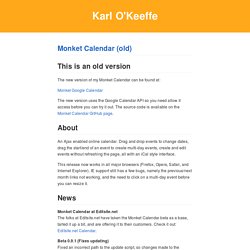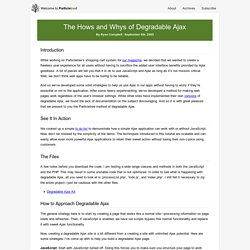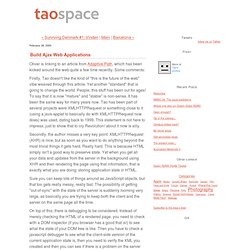

Calendar - Monket. This is an old version The new version of my Monket Calendar can be found at: Monket Google Calendar The new version uses the Google Calendar API so you need allow it access before you can try it out.

The source code is available on the Monket Calendar GitHub page. About An Ajax enabled online calendar. This release now works in all major browsers (Firefox, Opera, Safari, and Internet Explorer). News Monket Calendar at Editsite.net The folks at Editsite.net have taken the Monket Calendar beta as a base, tarted it up a bit, and are offering it to their customers. » The Web-based Office will have its day. I first profiled a Web 2.0 office in early September and since then more web-based office products have surfaced. Peter Rip posted recently that he's now "bumped into an alpha or beta Web-incarnation for every Microsoft desktop product". He says most are AJAX, but some are Flash or Flex-based (both Macromedia products). Peter thinks desktop apps are on the way out, because "no one works at their desktop anymore. " While he rightly points out that office people are spending more and more time on the Net, I don't agree with his conclusion that this necessarily signals the end of desktop apps - yet.
A recent Computerworld article states that laptops will soon replace the desktop as the preferred business PC, citing mobility as the main reason for this trend. However I do think that long-term, the writing is on the wall for desktop office applications. The time for the web-based office will come, mark my words. And ones Peter has added to the mix: Bindows Gliffy Meebo Zimbra. Death of the Desktop by Aza Raskin. General Interface Resource Center @ TIBCO Developer Network. Web Toolkit - Build AJAX apps in the Java language.
Joseph Scott’s Blog » Blog Archive » AJAX Edit In Place With Prototype, Version 0.2.0. UPDATE Thu 29 Nov 2007 @ 5:30pm : The Edit In Place code has a new home at editinplace.org UPDATE Fri 30 Jun 2006 @ 8:20am : You can find the latest Edit In Place blog posts at It has been almost two months since my since the first version of Edit In Place (version 0.1.0). Since then I’ve been trying to beef up some my JavaScript foo. I also discovered some problems with code that needed to fixed. So today I’m releasing version 0.2.0 of Edit In Place (eip). Doing OO in JavaScript is a bit strange. There are some new default CSS names used: Making IDs editable have new function calls as well: The EditInPlace.makeEditable() function only requires the id and save_url, the type option defaults to text. Id: false, save_url: false, css_class: 'eip_editable', savebutton: 'eip_savebutton', cancelbutton: 'eip_cancelbutton', saving: 'eip_saving', type: 'text' The css_class, savebutton, cancelbutton and saving are all CSS classes.
Max Kiesler - DesignDemo - Web 2.0, AJAX, and Rails UI Elements. The Hows and Whys of Degradable Ajax. Introduction While working on Particletree’s shopping cart system for our magazine, we decided that we wanted to create a flawless user experience for all users without having to sacrifice the added user interface benefits provided by Ajax goodness.

A lot of places will tell you that it is ok to use JavaScript and Ajax as long as it’s not mission critical. Well, we don’t think web apps have to be boring to be reliable. And so we’ve developed some solid strategies to help us use Ajax in our apps without having to worry if they’re essential or not to the application. After some heavy experimenting, we’ve developed a method for making web pages work regardless of the user’s browser settings. See It In Action We cooked up a simple to do list to demonstrate how a simple Ajax application can work with or without JavaScript.
The Files A few notes before you download the code. Del.icio.us/ghbrett. SAJAX - Simple Ajax Toolkit by ModernMethod - XMLHTTPRequest Toolkit for PHP. Guide to Using XMLHttpRequest (with Baby Steps) from WebPasties. Main Page - Ajax Patterns. AJAX. Ajax is not a single technology, but a group of technologies.

HTML and CSS can be used in combination to mark up and style information. The DOM is accessed with JavaScript to dynamically display, and allow the user to interact with, the information presented. JavaScript and the XMLHttpRequest object provide a method for exchanging data asynchronously between browser and server to avoid full page reloads. In 1996, the iframe tag was introduced by Internet Explorer to load or to fetch content asynchronously. In 1998, Microsoft Outlook Web App team implemented the first component XMLHTTP by client script. Google made a wide deployment of standards-compliant, cross browser Ajax with Gmail (2004) and Google Maps (2005).[6] Build Ajax Web Applications. Oliver is linking to an article from Adaptive Path, which has been kicked around the web quite a few time recently.

Some comments: Firstly, Tao doesn't like the kind of "this is the future of the web" vibe weaved through this article. Yet another "standard" that is going to change the world. People, this stuff has been out for ages! To say that it is now "mature" and "stable" is non-sense. Secondly, the author misses a very key point: XMLHTTPRequest (XHR) is nice, but as soon as you want to do anything beyond the most trivial things it gets hard.
Sure you can keep lots of things around as JavaScript objects, but that too gets really messy, really fast.